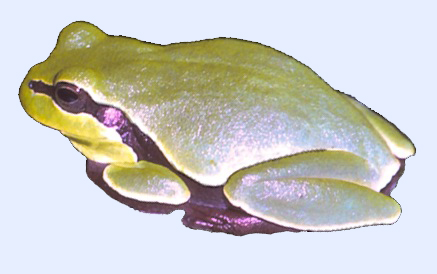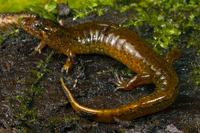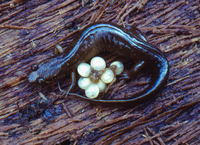Taxonomy
Class: AmphibiaOrder: CaudataFamily: PlethodontidaeSubfamily: Plethodontinae
Taxonomic Comments: Desmognathus fuscus -like populations in the Unicoi, Great Smoky, and Great Balsam ranges in western North Carolina were recognized as a new species, D. santeetlah , by Tilley (1981). This species consists of a series of high-elevation populations that differ in several characteristics from nearby low-elevation populations of what Tilley (1981) at the time considered to be D. fuscus . Tilley (1981) noted that D. santeetlah reaches sexual maturity at a slightly smaller size, is generally darker above with inconspicuous markings, has slightly different body proportions, and has fewer dorsal spots on the larvae. In addition, electrophoretic analyses show that the two forms are fixed for alternate electromorphs at three protein loci. Later studies revealed that what was thought to be D. fuscus at lower elevational sites that surround the range of D. santeetlah is not, and may represent a mixture of both D. conanti to the south and two members of an unresolved and perplexing complex of Desmognathus forms in eastern Tennessee to the north (see Tilley et al. 2013). D. santeetlah extensively interbreeds where it comes into geographic contact with the low-elevation forms in a broad geographic area along the northwest escarpment of the Great Smoky Mountains (Tilley 1981, 1988). Despite genetic and life history differences that occur between these groups, there is little evidence that D. santeetlah is reproductively isolated from the lower elevation forms based on genetic data and courtship trials (Tilley 1988, Maksymovitch and Verrell 1993, Verrell 1990). Populations of D. conanti and D. santeetlah in the Unicoi Mountains are separated by a slight elevational gap and do not have opportunities to interbreed there. D. conanti based on mtDNA, Beamer and Lamb (2020) recognize five major clades of D. conanti and found that D. santeetlah comprised a well-supported clade of its own. However, D. santeetlah was nested within a larger group that contained the five D. conanti clades. In addition, specimens that phenotypically resemble low-elevation D. conanti (but see Tilley et al. 2013) had haplotypes of D. santeetlah , a feature that likely reflects the widespread hybridization of these forms within the Great Smoky Mountains, and possible hybridization with D. conanti at some distant point in their evolutionary history. Desmognathus santeetlah is one of many taxonomically challenging groups of Desmognathus in eastern US (Beamer and Lamb 2020). Despite evidence of extensive hybridization with other forms, it is treated by authorities as a valid species, and we continue do so here. Species Comments:
Identification
Description: This is a medium-sized species of Desmognathus with a tail that is weakly keeled or trigonal distally. The toe tips lack cornifications and subsequently do not appear black-tipped. Most specimens are dull colored with yellowish-brown to greenish or greenish-brown coloration above. A straight or slightly undulating dorsolateral dark stripe is usually present, but is often thin, diffuse, and broken (Tilley 2000a). These stripes often enclose reddish pigment on the dorsum, particularly in younger specimens. Yellow pigmentation is most evident along the ventrolateral surfaces and under the base of the tail. Many specimens have numerous patches of iridophores scattered over their dorsal, lateral, and ventral surfaces, and the venter of many specimens has a "salt and pepper" pattern with a yellowish wash. Old individuals are usually greenish-brown dorsally and laterally, often with abundant iridophore patches but no other discernible dorsal pattern (Tilley 2000a). The hatchlings average around 8-9 mm SVL and the larvae have about 10 spots between the limbs that are often represented in the adults as depigmented areas or areas containing concentrations of reddish pigment. This species often coexists with several other Desmognathus species and is best identified in the field by a combination of size, the absence of cornified toe tips, the triagonal tail, and the yellowish wash that is often conspicuous on the underside of the tail. Hybrids are highly variable in coloration and patterning, and may consist of both dull and brightly colored and patterned individuals (Tilley 1988). Online Photos: Google iNaturalist Observation Methods: Specimens are most easily collected by turning rocks or other cover objects in or near streambeds or seeps. AmphibiaWeb Account
Distribution in North Carolina
Distribution Comments: Desmognathus santeetlah is restricted to the Unicoi, Cheoah, Great Smoky, and Great Balsam mountain ranges of the Blue Ridge in southwestern North Carolina and adjoining areas of eastern Tennessee (Tilley 1981, 2000a). The species ranges along the crest of the Great Balsam Mountains and Pisgah Ledge to at least as far as Pigeon Gap in Haywood-Transylvania counties (see range map above). The southern extent of its range in the Unicoi Mountains has not been established. This is mostly a high-elevation species, and pure forms has rarely been found below 3000 feet in elevation. Hybrids in the Great Smoky Mountains with D. conanti genes extend well into the lower valleys (Tilley 1988). Distribution Reference: Tilley (1981, 2000a)County Map: Clicking on a county returns the records for the species in that county.
GBIF Global Distribution
Key Habitat Requirements
Habitat: The Santeetlah Dusky Salamander is a semiaquatic species that is typically found in closed-canopy habitats in the immediate vicinity of cool seeps and headwater streams (Beane et al. 2010, Tilley 1981). Most specimens found by Petranka and Smith (2005) were either in the streambed proper or within 4 m of the streambed.
Life History and Autecology
Breeding and Courtship: Jones (1986) found males with the vasa packed with sperm during every month of his study (March-December), suggesting that courtship likely occurs throughout the warmer months of the years when adults are active. When courting, the adults engage in a set of rather stereotypic behaviors that appear to be essentially identical for D. conanti , D. santeetlah , and D. fuscus . Maksymovitch and Verrell (1992, 1993) provide details for D. santeetlah . The following general account of courtship behavior is from Petranka (1998).D. santeetlah and found statistically significant differences in levels of sexual compatibility among populations. These data are consistent with other studies of salamanders which indicate that aspects of mate recognition systems can diverge among conspecific populations in the absence of geographic isolation (Petranka 1998).Reproductive Mode: Females lay globular clusters of eggs during the summer months and brood them through hatching. They have most commonly been found beneath moss mats that cover rocks or logs in or along the edges of seepages or headwater streams. Jones (1986) found that most females oviposit from around mid-May through early July in the Unicoi Mountains. The clutch size of populations in the Smokies averages around 17-20 eggs (Beachy 1993b, Tilley 1988), while Jones (1986) reported a mean of 23 ova in Unicoi populations. Aquatic Life History: Dietary studies have not been conducted for the larvae, but they presumably feed on tiny invertebrates such as midge larvae that are found in seepages and streams. The larval period of populations in the Unicoi Mountains appears to be slightly less than 1 year, with the smallest metamorphs ranging from 9-12 mm SVL (Jones 1986). Terrestrial Life History: The juveniles and adults live in close proximity to running water. The diet is undocumented, but they presumably are opportunistic, generalist predators on invertebrates like other dusky salamanders. Jones (1986) found that males begin to reach sexual maturity when around 30 mm SVL, versus 33–35 mm SVL for females. The males reach sexual maturity when around 2-years old, while females require an additional year of growth.
General Ecology
Adverse Environmental Impacts
Status in North Carolina
NHP State Rank: S3S4Global Rank: G3G4QStatus in North Carolina: W2Environmental Threats: Most populations of the Santeetlah Dusky Salamander are in either the Great Smoky Mountains National Park, the Blue Ridge Parkway, or national forests and are protected from environmental disturbances from mining and intensive timber harvesting. Feral hogs often disturb seepages and could potentially impact populations by consuming salamanders or destroying nesting microhabitats.

 »
»



 »
»

